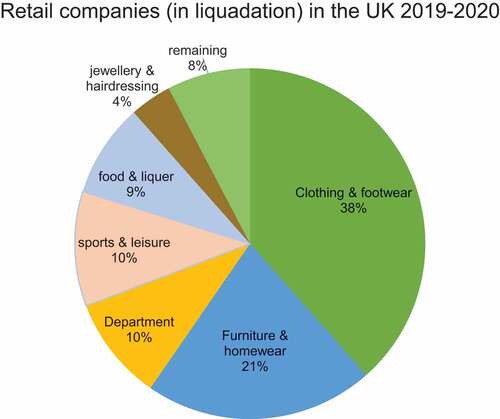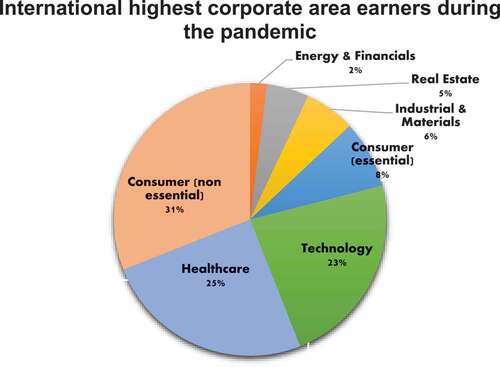ABSTRACT
Smart cities carry the burden of utilizing technologies to support city life during and beyond the Covid-19 pandemic. More than ever, true smartness needs to address the broader health implications of the shared urban space. Especially highly populated cities tend to suffer more from the consequences of Covid-19 than rural areas. Without a doubt, the pandemic has revealed particular weaknesses of the existing urban environment, in urban space and population demographics, so evident of unprepared city infrastructure systems. The traditional design of public space has created inequalities, and such space design serves the needs of a commercialized urban context and enables public gatherings or private/commercial access. The sudden behavioral shift needed in cities means that smart solutions are also needed for the health and well-being of city populations. This paper examines the impact in the urban environments for London, Manchester, Newcastle, and Liverpool. This paper maps the implications of physical distancing due to Covid-19 using cases studies in three main areas: i) roads, ii) parks, and iii) retail. A matrix of urban, social, and health consequences is suggested, which will shape urban policy. It will focus on terms of access and use of urban space during the pandemic and beyond. The expected outcome of this research is to map some of the metropolitan area to demonstrate restrictions, changes in sharing behavior, and gamification opportunities of urban space. The expected outcomes will provide evidence-based scenarios for gamification technologies (for example, wayfinding, location, and character-based) of the challenged urban space in roads, parks, and retail to support change in future policy. The paper will discuss the implications of behavior change and consider so-called “gamification” practices in the urban space, using examples of social distancing, movement tracing, and techniques that add to a truly smart city. Overall, the aim is to demonstrate the spatial constraints of Covid-19; social distancing as the main challenge and to explore how the design of urban form and smart systems will provide for a healthy and resilient urban environment. This research addresses good urban health and a playful approach to the new way of urban living.
1. Introduction
While the Covid-19 pandemic fatalities and cases continue to rise (except for the Asian context), the world is looking for ways to adapt to the current situation. According to the World Health Organization Data (Citation2009), there are six stages of what it defines as a pandemic. The three first describe an ambiguous situation and peak spreading, and the other three represent the negative peak (ESRI, Citation2020). This paper sees the effects of the pandemic through the urban lens. When this paper was written, (Last quarter of 2020), the consequences have affected dense urban centers the most. For example, metropolises like New York and London seemed to have suffered more than areas not in that high density.
Measures reducing the spread of the virus include imposed local lockdowns; these affect big cities significantly. Confinement has indirect impacts in the broader environment; for example, working from the home model has reduced automobile use, potentially lowering emissions. However, it also has affected the local economies, forced unemployment, building on existing inequalities, and exacerbated the social implications, while new forms of employment demand rapid skill development and lower-paid employment. New systems and approaches have been enforced rapidly. We need to go beyond the immediate Covid-19 to consider the Livability effects of this change in the urban environment, the social and health implications. This paper explores the broader impact on the urban environment and how the three areas have been affected.
The goal of this paper is to implement serious games using policy recommendations. The aim here is to understand how urban areas are impacted and evaluate the challenges and opportunities. This research aims to understand the current literature landscape, use publicly available data concerning the indirect effects of Covid-19 and use data in an evidence-based approach and generate recommendations to design and develop serious gaming. The expected outcomes will then underpin urban design policy and create gamification. However, there are limitations in the literature; we do not have years of study and limited time-based data. We will now explore the current literature on the broader implications of Covid-19.
2. Effects of Covid-19 in the urban, social, and the health context (Literature Review)
For almost a year now, cities on a local and international scale have experienced huge stresses. Constrains are in place to protect people from contracting the virus, and Covid-19 measures have implications in a broader city agenda. Once recognized as desirable for cities, growth is overturned; cities now measure negative progress in economy, education, and social situations ()
Figure 1. Number of confirmed cases in major UK cities (Centre for Cities, Citation2020).
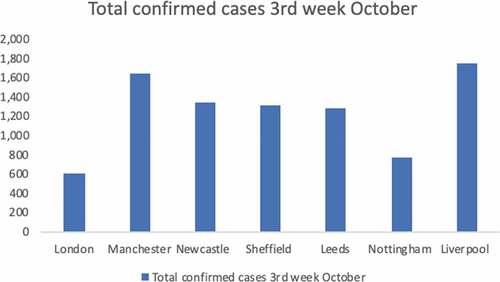
2.1. The urban impact
There is limited literature on an urban approach for Covid-19, understandably a recent topic which we are still experiencing its impact. Before the restrictions brought about by the pandemic, the urban literature was concerned with urban development, climate change, sustainability, digitalization; these are just some of them. The recent pandemic has affected urban living. This will be evident in the future urban literature, as Covid-19 has not been associated as an urban issue, which is evident in current literature. Using “Covid” and “Urban” as title keywords (28th September 2020) in Science Direct yields 154 results; published in 2020. In total, 224 academic resources, most of these in 49 of these are in the Environmental Sciences, and the rest 28 in Cities, Urban Studies, and Regional Urban Planning. Most of these publications focus on how countries (or specific areas) respond to the urban restrictions from Covid-19 but lack urban interventions or solutions. In contrast, results yielded using “Covid” in the search titles show more than 28,000 results, Science Direct more than 16,000 results. As expected, Covid-19 is mainly associated with epidemiological, psychological, and medical issues in most publications. There is little research in terms of an urban approach in which urban science can offer to ease the effects of a pandemic on an urban scale. As Mills (Citation2020) suggests, the pandemic has revealed a new urban reality: connectedness and the difficulty of foreseeing the future. Furthermore, Covid-19 has identified certain urban design factors such as greening up cities that need attention; this is one of the urban views related to urban matters and Covid-19 (Kleinschroth & Kowarik, Citation2020). The urban “planning” or “design” has become far more complex in the Covid-19 situation (Boschetto, Citation2020). Therefore, rapidly expanding urban trends concerning health might emerge, as one of the parameters of smartness is inevitable (Allam & Jones, Citation2020). However, research into how these urban trends have been impacted would bring vast opportunities into urban research and the impacts from the Covid-19 pandemic.
2.2. The social impact
The effects of a pandemic are severe because they cover a broad social spectrum and impact the overall health, not only individual health in terms of Covid-19. For example, whole communities affected, and those who seek occurring support (such as those in need or the elderly) are considered vulnerable groups that need regular contact (Xiang et al., Citation2020). Furthermore, the effects are found to be more severe in the intensive poor areas: slums in India, where social distancing is almost impossible, and where access to organized support (food and sanitation supplies) became challenging due to the people concentrations and density (Wasdani & Prasad, Citation2020). Additional societal challenges are now exacerbated: for example, Lechner et al. (Citation2020) found an increase in alcohol abuse in organizations. University closure had a similar impact, whilst online digital interventions could be used to prevent similar addictions (Lechner et al., Citation2020). This means that responding to a society that has shifted because of the spatial restrictions to combat spreading added a new layer of response and potentially the need to respond to these distancing rules using digital technology; Naples, for example, developed a system to map local initiatives to support food distribution managed by local stakeholders (Cattivelli & Rusciano, Citation2020). Part of the social realm has shown a fall of approximately 5% of the global GDP, bringing catastrophic consequences in many sectors, like tourism, traveling, and long distancing connections; these could lower environmental distress (Qiu et al., Citation2020). Inevitably the economic effects will bring broader social challenges, for example, the UK, according to the OECD faces a −10% in Interim Economic Outlook Forecast, EU by a −8%, and India, South Africa, Argentina are some of the countries with a negative of above 10%).
2.3. The health impact
Health in this pandemic has overarching implications, and in the urban context, significant effects emerged from spatial implications. Besides, social distancing is only one of the measures to tackle contracting the virus; using face masks, staying at home are enforced measures to tackle contracting the virus. While they might limit the virus spread, these measures can harm the overall health, mainly mental health, increase loneliness and become detrimental for social cohesion, even social unrest soon. Social distancing has resulted in a reduction by half in transmitting the virus, even in most populated contexts, for example, in Hong Kong, despite being known for its highly shared space (Noh et al., Citation2020). In comparison, living in rural areas could be considered a healthier practice during the pandemic due to access to open spaces; this is true; cities suffered the highest number of cases and victims. It is no coincidence that cities require such solutions since they have the most points (at the time of this paper was written); cities like Liverpool, Leeds, Manchester, Newcastle, and Nottingham in the UK are among 10 cities with the highest number of Covid-19 (Centre for Cities, Citation2020).
Living in rural areas reveals a different story: rural areas lack the infrastructure to support people during the pandemic, for example, access to emergency healthcare and the infrastructure for organized living, which can be found already in the urban areas (Malatzky et al., Citation2020). There is still unprecedented information on the impact of the virus on overall health, and developments underline the fact that we have now yet to come to terms with the wide spectrum of the challenges or how to overcome them (Rollett et al., Citation2020). Shaw et al. (Citation2020)suggest, government plays a vital role, governments which were more efficient in tackling health issues and the pandemic impact, implemented a decision-making mechanism of control, transparency, and clarity and digitalization can play a supporting role as a recovery system in cities to support behavioral change which could lead to policy development. Such a systematic approach to recovery from Covid-19 considers shifting toward a smart approach that manages the urban process using digital technologies and can also foresee environmental effects (Sharifi & Khavarian-Garmsir, Citation2020). This is the time of inevitable change in the urban system, and a truly smart agenda can support this change toward liveable solutions to support overall health during and after a pandemic (Acuto, Citation2020; Cavada, Citation2019; Cavada et al., Citation2017).
Current literature on how the Covid-19 pandemic impacts the urban realm is minimal, and it is too early to explore how the urban trends are shifting. This means that there is a wide research area to explore and will potentially turn current urban trends. Additionally, the effects of the virus extend to a broader social area than the health impact, for example, social distancing has reduced human contact short term, and the long-term effects of the economy are yet to be explored. Often digital solutions are replacing social interactions and some of the economic challenges (working from home). Covid-19 has impacted overall health, exacerbating challenges; drinking and mental issues are only some of them. Solutions to these challenges are implemented by digital systems and guidance by national and international governance strategies. Any response to these issues requires a dynamic approach in the urban and spatial decision making is vital for localities. Models and assessment tools should be in place to evaluate impact and support decision-making. In the next Section, a tool methodology explained is used in this paper to explore the effects of the pandemic in the urban realm.
3. Overview of Covid-19 effects in urban realm (Roads, Parks, and Retail)
As in most places, the pandemic affected the way we live in urban centers. Foremost, because of the national lockdown, where residents were instructed to stay indoors. This section describes mobility, open spaces, and the local economy – which effectively impacts the national economy. For example, as shows, there was a significant impact on work, transport, and retail. About a third of each of these activities was negatively impacted. This diagram also shows that residencies and parks had increased activity by a third.
Figure 2. Percentage of amenities (usage) during the pandemic, UK. (Google Community Mobility Report, Citation2020).
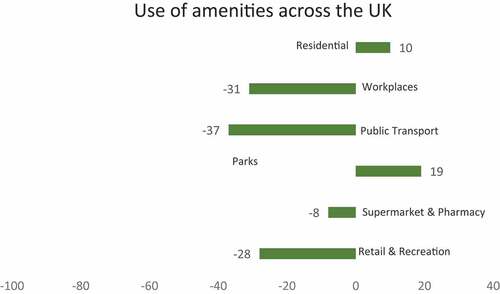
As many expected, from the central office in the city to the home office confinement, the workplace changes also led to behavioral change in how people spend leisure time. The effects from the pandemic are being explored through urban parameters. These can vary, for example, Sharifi and Khavarian-Garmsir (Citation2020) used environmental, socio-economic, management, and mobility. In contrast, a private organization reviews the effects in wider agendas (data, inequality, services are some of them) and explores the urban context in terms of mobility and open spaces (KPMG, Citation2021). World Health Organization’s (Citation2021) urban view from the pandemic is using case studies to explore the urban responses to Covid-19 focusing on systems for resilience. This literature review, explored in Section 1, discussed some of the urban effects (urban, socio-economics, and health); this research proposes an exploration to capture mobility in urban areas (roads), socio-economic (retail), and open areas which contribute to overall health (parks).
Additionally, as shows, these were negatively impacted, and parks were impacted positively. This is also demonstrated in , where these three areas show a significant impact, a reduction of the use of amenities in retail and public transport, yet a minor effect on parks across all four cities. Data from the Covid-19 Community Mobility Report (Citation2020) shows the trends according to four major cities. Especially in Newcastle, the use of parks rose by 7%. In London, retail activity dropped by more than half, while its use of parks only dropped by 9% ()
Figure 3. Selection of 4 UK cities; use of amenities retail, parks, and roads (Google Community Mobility Report, Citation2020).
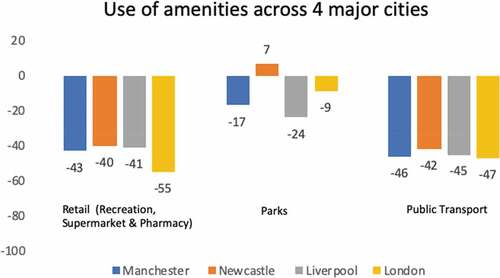
An initial observation for this behavioral change is the use of parks, a practice supported by initiatives like “Slow Ways,” which is a collaboration between a geographer, GetOutside, and the Ordnance Survey, which maps the walkable paths across the UK and encourages healthy practices of outdoor activity and walking (Ellison, Citation2020). In the next section, the research explores the changes in these three areas (roads, parks, and retail).
3.1. Roads
Organizations are developing technologies using sensors in cameras that can translate into information, provide measurable results for public transport and private areas, and collaborate with local or national governance recommendations (Hoxton Analysis, Citationn.d.; Swarm Analytics, Citation2020). Newcastle University is using previous and currently developed smart city technologies to understand social distancing measures, which according to the Urban Observatory, only 5% of pedestrians were presently active during the national lockdown (People Movement Monitoring Dashboard. The Newcastle Urban Observatory 2019).
Mobility data from Apple shows some interesting trends in the change in mobility, in three areas driving, transit, and walking, but not considering cycling as a method of mobility. Overall, in the UK, transit (describing the transport of people and goods) showed the most significant decrease ( offer a ten-day point from the 13th January to the 17th September 2020) since the national lockdown (16th March – 64 in ). Driving in the UK decreased drastically and walking seemed preferred; however, once the measures lifted, driving trends rose (APPLE, Citation2020).
Figure 4. Trends of mobility in the UK before and during the pandemic (APPLE, Citation2020).

Figure 5. Trends of mobility in London before and during the pandemic (APPLE, Citation2020).
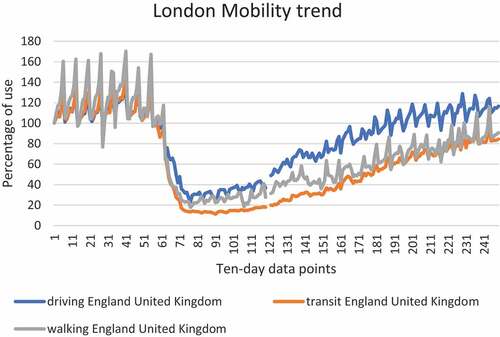
On a similar note, the mobility trend in London (ibid) shows the effect of the individual measures against the pandemic, where using automobiles over public transport was by far the most preferred method. Even so, transit seems to stay on a similar level to walking; the mediating factor here is perhaps that London as an international location will have more transit anyway due to airports and goods transportation. It covers a wider geographic area, for residents to move around in.
A comparison across the UK transport trends saw the pandemic effects on roads during and after the lockdown, when its traffics gradually increased. shows that once the measures were lifted, car use (driving) advanced to the levels before Covid measures were implemented; maybe people feel safer in their private cars rather than sharing public transport. This may be attributed to the fact that personal vehicles provided a sense of safety and distancing. This comparison shows mobility trends can be different in large cities compared to the country, and any additional mediating measures might address or affect urban centers differently. Not just in terms of the city size, but also connections to other cities or countries might affect the level of mobility required, for example, the links of large cities like London might have to cities outside the UK.
3.2. Parks
Social distancing was enforced at the beginning of the pandemic in the UK (March 2020) to limit the outbreak of Covid-19 (a minimum of the two-meter distance between members outside the housing environment) (Cabinet Office, Citation2020). The benefit for public health has also developed s77ome unintended benefits. More than half of the population in non-affected areas and more than 65% in lockdown areas have experienced the loss of personal freedom of movement (OS Ordnance Survey, Citation2020). Advice from the central government clarifies that exercising outdoors and in parks are recommended for exercise and well-being during the pandemic (London Assembly, Citation2020a). This also seemed like an opportunity for the government to support the use of the green areas safely and enjoyably (Gov, Citation2020 Guidance). Advice from the National Health Service in the UK (NHS) has been for all age groups to exercise daily regardless of the current measures (NHS, Citation2019a). Open green areas and parks are likely to be enjoyed differently throughout the year, for example, in winter are less accessed while in spring and summer times become popular for outdoor activity and socialization. Here, there is some consideration for cycling as a leisure activity, thus linked to this section.
However, data collection has proved a limitation to understanding the effect and value of parks during the Covid-19. According to Sim and Miller (Citation2019), data for parks does not exist, while their research used partially gathered data and data from social media. Mainly from the London Datastore, the open-shared data portal (London Assembly, Citation2020b) a search using the term “parks” yields eight datasets in the Environment topic – 3 of them relate to parking or industrial use, and the rest five refer to areas of green infrastructure in London. In planning, 13 datasets refer to Industrial Location points, Infrastructure maps, or related cycling infrastructure (search 14th October). This enforces the assumption that public data for park use does not exist, although the benefits concerning parks and activity were reinforced during the pandemic. Several opportunities arise for gamification and involvement from organizations in supporting data gathering.
Sustrans, a charity with walking and cycling goals (Sustrans, Citation2020a), collaborates with Transport for London (TfL) to provide improvements for the urban realm (Sustrans, Citation2020b) and support walking and cycling. TfL also collaborates with Go Jauntly (Citation2018) which provides routes for walking in London and also works as sharing information between friends. Similarly, Green Chain Walk (TfL, 2020) is a 50 mile path that connects all green areas between Thamesmead and Nunhead Cemetery in the capital. The complete mapping of green areas can be accessed (London Green Cover [LGC], Citation2016) this shows the green areas in London and London’s Green Infrastructure (GIM, Citation2018) can provide a base for developing solutions using new technologies and offer opportunities for data collection. The Greenspace Information for Greater London (GiGL, Citation2018) which holds London’s environmental information published a list of the various publicly accessible spaces; they state that every house in London is less than half a kilometer away from a small green area and about half a kilometer from a park. This needs further exploration, as the home could be considered a tower block with 20 floors, and they all have equal access to green space. By default, it probably does not mean equal access to the open and green areas, as access to these should be measured by the number of people and maybe not of the building as one object.
Parks during Covid-19 present a breather for those in confinement; social, healthy, and esthetic reasons all add to the benefits that park openings, city pockets offer. However, parks’ study and data collection need to take cognizance of the different variants, use during the seasons, day and time, and social aspects. Access to parks unveils deep urban inequalities, with access to these being critical to people’s health and well-being. Although it is now acknowledged they may be the primary source for exercise and well-being, access can be restricted because of physical inability to walk there, safety, and visual restriction from residencies. At the time of the need for accessibility, it is encouraging the development of methods using current technologies to provide current opportunities in support of the green and open areas.
3.3. Retail
Compared to how roads and parks were explored, retail (here considered retail goods – not including hospitality, hotels, or restaurants) shows the most significant impact. The biggest threat of the lockdown has probably been to have adverse economic effects in cities and the wider UK context. Most UK cities follow the model of medium commercial activity, a high street designed to hold most of the retail activity in the center of the city. Mainly, during weekends, retail activity makes a highly populated high street, especially during weekends where it is the principal commercial activity, also considering additional leisure activity, for example, restaurants and bars. Additionally, charity retail flourished as part of the high street, providing social benefits through volunteering satisfaction and low-cost retail activity (Harrison-Evans, Citation2016). During the first months of the lockdown, charity shops were receiving higher volumes of donations and, during economic recessions, have seen a rise in their sales but have seen some of their high street stores closing (Collinson, Citation2020). High rent prices and distribution of activities across the most central parts of the center are challenges from the central retail district. Another example on the high street is any business operating on the high street (for example, agents, estate, a holiday is some of them), which could use during the Tier 4 as they are considered a business and not part of retail (Gov UK, Citation2020). Under the lockdown agendas, the UK Highstreet seemed to suffer the most during the national lockdown and several local confinements following the “opening up.” In terms of activity, there was minimum human interaction in the center and the high street; in commercial activity, the effects were quite overwhelming. As shows, between 2019 and 2020, 38% of Fashion retailers (Clothing & Footwear) went into liquidation. A further 21% of Furniture and Homeware stores and 10% of the Department stores also stopped operating. This overall, 69% of the companies in liquidation has a massive effect in the economy, unemployment, human activity, and interaction and evidently, can lead to a significant decline of the UK High Street.
For cities, the fact that centers decline affects areas, in terms of empty properties, unpaid rent, deserted streets, and potentially isolation and anti-social behavior. In contrast, the demand for online shopping and the retail response is illustrated by companies with the highest profit during the current pandemic (FT2020). As shows, three major sectors were profitable during the pandemic. These are the non-essential, healthcare, and technology covered the highest portion of the profit-gain. The first 10 of these lists are Zoom video (270% profit, third position), Just Eat takeaway (160% profit, sixth position), Tesla (140% profit, eighth position), and Wayfair (130% profit, tenth position) (ibid).
The problem of the high street had already been recognized pre-Covid, for example, the £1 billion Future High Streets Fund (Gov PR, Citation2020) and further financial support to re-open closed shops (Stoke-on-Trent, Bradford, Rochford, Kettering, and Slough) for a low retail activity local groups and communities (Gov PR 2019B). But further additional support was announced in June 2020 (Gov PR, Citation2020) from the £50 million Reopening High Street Safety Fund (MHCLG, Citation2020).
However, in terms of urban design, the economic decline of the high street and the pandemic impact has a further negative impact; empty streets, lack of social cohesion, negative experience for walkability are some of the potential effects. However, there may be spatial variations in the difference between city center high streets and the local community’s high streets. With patterns of work and travel changing as we come out of aspects of lockdown, perhaps communities and local high streets will reinvent themselves.
4. Assessing smartness on the Covid-19 impact
To develop the strategies to support gamification in response to the Covid-19 urban impact, this paper suggests an evaluation according to the four Lenses (Society, Environmental, Economy, and Governance) found in the smart research (Cavada, Citation2019). This will allow articulating gamification technologies according to added benefits of being “truly smart” (Cavada, Citation2019). For this reason, the methodology follows three steps:
Create a matrix using the context (urban, social, health) and the effects on the urban elements (roads, parks, and retail) as explored in Sections 1 & 2.
Evaluate the matrix using the four Lenses.
Demonstrate the potential benefits according to the “truly smart” assessment (Cavada, Citation2019).
illustrates the matrix, assessing the effects of “roads, retail, parks” to “urban, social, and health” and the benefits that are provided in terms of the “society, environment, economy, and governance.”
Figure 8. Smart assessment methodology (Cavada, Citation2019, adapted).
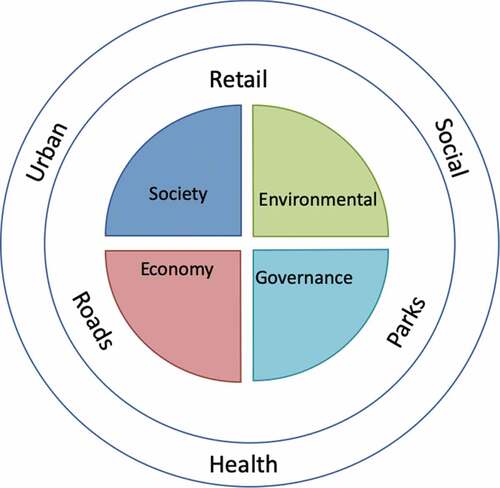
It is anticipated that the research will reveal limitations in data collection, for example, data on parks usage and due to pandemic restrictions of physical collection of data. A matrix is a basis for evaluating and exploring which Lenses are impacted by the Covid-19 urban effects.
5. Discussion of the findings
While we are in the middle of a pandemic and, according to the WHO (Citation2021), probably experiencing an uncertain future, while many suffer the health implications of the virus, additional stresses are upon livability aspects, social, urban, and the wider health. This paper developed a matrix across the context and urban elements to understand the opportunities for gamification according to the truly smart agenda. In , the matrix is evaluated according to the Lenses. For example, the effects on the Urban-Roads can benefit the Environmental Lens (because of lower carbon emissions) and the governance of resources and mobility; therefore, the two-quarters of the circle (green-blue) appear on the matrix. In addition, on the Retail-Social there are no benefits for any of the lenses (due to the socio-economic effects of Covid-19); however, in Retail-Health, benefits lie in the Economy Lens.
Previous research has shown that gamification methods can add to the “truly smart” agenda and enhance walkability, social skills, and support education for the younger generation (Cavada and Rogers, 2020). In their paper (ibid) three identified gamification technologies potentially can support smartness development, these are location-based (interaction technologies able to connect users with the urban context), way-finding (which can provide data from the urban context), and self-identification (where a user can be part of a storyline). These gamification technologies could offer alternatives during and post pandemics to support solutions to change the negative impact of Covid-19. In the retail case, gamification technologies can develop social skills and parks to provide shared economic benefits or make a case for available data. Evaluating the effects of Covid-19 using the Lenses can also provide scenarios for gamification technologies, for example, way-finding solutions for safe navigation when social distancing is enforced, or even to support vaccination practices.
This research aimed to demonstrate that implementing truly smart gamification strategies for and during the pandemic can change the negative effects of Covid-19 and promote recovery for the urban environment. For this reason, this research developed a matrix of “retail, roads, and parks” to evaluate the benefits according to the truly smart Lenses during and after the pandemic. Currently, there is a lack of data in measuring parks in cities and further exploration needs to be considered – gamification technologies (wayfinding) can support this. It is important, as these technologies can offer location data, sharing of assessment during pandemics. Also, provide educational tools for individuals or the education sector using the findings. These technologies are a way to develop social interaction (which seemed to also been hit due to retail) and provide support while living and working during lockdowns. This research can support gamification design, providing evidence for practices, data collection, national or local for cities, and decision-making. It is proposed that further research can identify technologies, which can materialize the strategies presented in this research.
Previous research has shown that gamification technologies can add to the “truly smart” agenda, adding benefits to societal and urban systems and these would need to explore gamification methodologies for cities (Cavada and Rogers, 2020).
While many places still suffer from the health implications of the virus, additional stresses are upon livability aspects, social, urban, and wider health. This paper used a matrix of these across three urban elements (roads, retail, and parks) to deeply understand the challenges and opportunities. It is suggested that gamification methods can support solutions to ease the effects of the pandemic, offering opportunities to alternative mobility scenarios, reviving the High Street, and support the local economy. These might have been thought as practices to support truly smart and liveable solutions gamification should be designed as a system; for example, way-finding solutions need to demonstrate the shared benefits of the urban area and how this intervention can impact parts of the system (Cavada and Rogers, 2020).
This research aimed to demonstrate that implementing truly smart gamification strategies for and during the pandemic can promote recovery for the urban setting. For this reason, this research developed a matrix of “retail, roads, and parks” to evaluate the commonalities and opportunities during and after the pandemic. Currently, there is a lack of data in measuring parks in cities and further exploration needs to be considered – gamification technologies (wayfinding) can support this. As these technologies can offer location data, ensuring open sharing of these datasets and assessments is important. Also, provide educational tools for individuals or the education sector using the findings. These technologies are a way to develop social interaction (which seemed to also been hit due to retail) and provide support while living and working during lockdowns. This research can support the design of serious gaming providing evidence for practices, data collection, national or local for cities, and decision-making. It is proposed that further research can identify technologies, which can materialize the strategies suggested in this research.
6. Conclusions: Strategies for gamification
As explored, the effects of Covid-19 impacted public health and the way we live, consume, and go about in cities. The impacts of these behaviors are evaluated according to the smart city assessment’s benefits (Cavada, Citation2019). This research explored the available data on roads, retail, and parks to reflect the changes from Covid-19 on the urban context during the first months of the enforced lockdown. Although there is no national data for parks, there is plenty of evidence that parks data on sites exist online, along with support from organizations. , marks where the four Lenses (society, environment, economy, and governance) have been positively impacted by the lockdown effects. For example, the impact on roads positively impacted the urban environment and governance due to the understanding of national data on mobility in terms of social context. There were fewer costs related to car use and a positive impact in terms of health. At the same time, there were many opportunities to use public available data to develop governance systems and support other mobility methods in the city.
Figure 9. Assessment of the impact in Roads, Retail, and Parks using the four Lenses (key) from the lockdown restrictions.
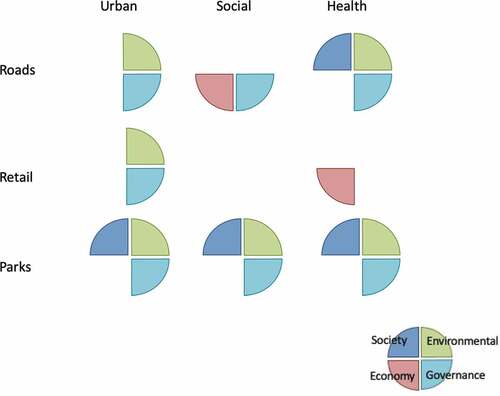
In the same way, the research evaluated the available data, which showed the initial assumptions of retail had hit the hardest. In contrast, roads offer different benefits for each context, and the use and value of parks is a factor to consider for a future pandemic context. Parks can support social interactions between users, even during restrictions, can meet up and socialize within a safe distance. Hence, there is the need to consider the relationship between movement, retail, and green space in a more exciting way in a pandemic scenario. Research showed that people can claim ownership for their context by using serious gaming to develop also embedding smart and liveable practises (Papangelis, Metzger, et al., Citation2017, Citation2020). It was evident that the economy is the most challenging aspect of the pandemic; it negatively impacts all urban, social, and health conditions in the city context. However, there are also opportunities for governance, mainly through the availability of data and strategic decision-making. The high street might not be the place for low commercial use anymore; territorial technology can develop and reinforce social relations and learning between the physical and digital space (Papangelis, Sheng, et al., Citation2017).
The numerous changes that the current pandemic has brought in cities are seen here through the lens of the urban approach. According to the findings of this paper, there are opportunities, which can support gamification and lead to the development of gamification methodologies, to support and ease interactions during pandemics. Currently, it is challenging to have a full view, as there is a significant lack of park data in terms of their use. It is necessary to have the ability to explore how and when parks are used and be able to make predictions for their use during a potential health threat. Ability to analyze parks or green infrastructure datasets will lead to better design gamification technologies providing overarching health benefits. Another impact of the parks “data gap” is that is limiting our ability to support arguments relating to the social interactions of parks. This is also essential because data can be used in parks’ gamification design, emphasizing the use of parks during times of health confinements. Based on the findings’ discussion, this paper recommends strategies for designing gamification technologies according to the smart Lenses:
Society: a reduction in transportation showed benefits in parks while human interactions were hit hard due to confinement. It is suggested that gamification (for example, location-based and way finding) technologies should provide the digital space for human and place connections.
Environmental: likely the area with the most benefits, due to mobility reduction, but this did not benefit to the overall economy.
Provide detailed analysis according to place. Way-finding technologies could promote and measure park and open space use and provide detailed analysis in support of the parks use and social activity within them to support policy for park resilience.
Economy: highly affected from Covid-19, in terms of retail and socialization.
Self-identification technologies should support retail and also socialisation. Support green business models and data development. Using self-identification technologies for online personas to interact and promote local character and advance local retail businesses.
Governance: there is an opportunity to test and implement solutions using alternative governance scenarios. Probably the widest of opportunities here, governing and developing alternative mobility scenarios for social distancing. Additionally, using self-identification technologies to develop democratic approaches to governance systems
Furthermore, gamification methods can be used for self-contact tracing and organizing remedies for Covid-19, for example, rolling out of vaccination or medication. Further research could develop smart initiatives using gamification methods and technologies. Some of the recommendations (for example, the use of parks) were suggested before Covid-19, now and in the future are considered a matter of urgency (NHS, Citation2019a, Citationb; Sutrans, Citation2019).
Acknowledgments
The author gratefully acknowledges the financial support of the Imagination Lancaster funded by the Expanding Excellence in England Fund (E3). Research England.
Disclosure statement
No potential conflict of interest was reported by the author(s).
Additional information
Funding
Notes on contributors
Marianna Cavada
Marianna Cavada is a lecturer in Urban Design Policy and a UK registered Architect ARB UK. She is currently teaching at the School of Architecture at Lancaster University. Her research is focused on cities, underpinned by engineering methods. She is researching how to design urban policy for people with people.
References
- Acuto, M. (2020, April 24). Commentary COVID-19: Lessons for an Urban(izing) world. One Earth, 2(4), 317–319. Cell Press. https://doi.org/10.1016/j.oneear.2020.04.004
- Allam, Z., & Jones, D. S. (2020). On the Coronavirus (COVID-19) outbreak and the smart city network: Universal data sharing standards coupled with Artificial Intelligence (AI) to benefit urban health monitoring and management. Healthcare, 8(1), 46. https://doi.org/10.3390/healthcare8010046
- Angelo, H., & Waschsmuth, D. (2020). Special issue article: Why does everyone think cities can save the planet”? Urban Studies Journal Limited, 57(11), 2201–2221. Sage. https://doi.org/10.1177/0042098020919081
- APPLE. (2020). Retrieved October 15, 2020, from https://covid19.apple.com/mobility
- Boschetto, P. (2020). Covid-19 and simplification of urban planning tools. The residual plan. TeMA - Journal of Land Use, Mobility and Environment, 9–16. https://doi.org/10.6092/1970-9870/6845
- Cabinet Office. (2020). Retrieved September 27, 2020, from https://www.gov.uk/government/publications/coronavirus-covid-19-meeting-with-others-safely-social-distancing/coronavirus-covid-19-meeting-with-others-safely-social-distancing
- Cattivelli, V., & Rusciano, V. (2020). Case report social innovation and food provisioning during Covid-19: The case of urban–rural initiatives in the province of Naples. Sustainability Sustainability, 12(11), 4444MDPI. https://doi.org/10.3390/su12114444
- Cavada, M., Hunt, D. V. L, and Rogers, C. D. F. (2017). Do smart cities realise their potential for lower carbon dioxide emissions? Proceedings of the Institution of Civil Engineers - Engineering Sustainability, 169(6), 243–252.
- Cavada (2019). Smart Model Assessment Resilient Tool (SMART): A Tool for Assessing Truly Smart Cities. University of Birmingham, UK.
- Centre for Cities. (2020). Retrieved October 15, 2020, from https://public.tableau.com/views/HighStreetsTracker/Highstreetstracker?:display_count=y&publish=yes&:origin=viz_share_link&:showVizHome=no
- Chris Michael, C., McMullan, L., & Jones, F. H. (2020). From garden streets to bike highways: Four ideas for post-Covid cities – Visualised. The Guardian. Retrieved September 27, 2020, from https://www.theguardian.com/cities/ng-interactive/2020/sep/25/garden-streets-bike-superhighways-cities-future-coronavirus
- Collinson, P. (2020) UK charity shops sales suffer despite lockdown ‘decluttering.’ The Guardian. Retrieved February 25, 2020, from https://www.theguardian.com/society/2020/aug/15/uk-charity-shops-sales-suffer-despite-lockdown-decluttering
- Data Dashboard, D. D. (2020) Centre for Cities. “Where in England has the highest number of new Coronavirus cases”? Retrieved October 15, 2020, from https://www.centreforcities.org/data/coronavirus-cases-uk-cities-large-towns/
- Ellison, D. R. (2020). Slow ways. Retrieved October 17, 2020, from https://ravenellison.com/portfolio/slow-ways/
- ESRI. (2020). Retrieved October 20, 2020, from https://coronavirus-resources.esri.com/datasets/a16bb8b137ba4d8bbe645301b80e5740
- FT Financial Times. (2020). Retrieved October 10, 2020, from https://www.ft.com/content/844ed28c-8074-4856-bde0-20f3bf4cd8f0
- GBHS. (2019a). Retrieved October 15, 2020, from https://thegreatbritishhighstreet.co.uk/high-street-news/case-studies
- GBHS. (2019b). Retrieved October 15, 2020, from https://thegreatbritishhighstreet.co.uk/high-street-of-the-year-awards/the-winners
- GiGL. (2018). Retrieved October 17, 2020, from https://www.gigl.org.uk/open-spaces/public-open-space-categories/
- GIM. (2018). Retrieved October 15, 2020, from https://maps.london.gov.uk/green-infrastructure/
- Go Jauntly. (2018). Retrieved October 12, 2020, from https://www.gojauntly.com/blog/2018/11/28/go-jauntly-version-2?intcmp=56645&intcmp=56822
- Google. (2020). COVID-19 community mobility reports. Retrieved October 9, 2021, from https://www.google.com/covid19/mobility/
- Gov PR. (2020). Retrieved October 15, 2020, fromhttps://www.gov.uk/government/news/new-support-for-reopening-and-recovery-of-high-streets
- Gov. (2019a). Press Release B Retrieved October 15, 2020, from https://www.gov.uk/government/news/britain-opens-its-doors-to-communities-in-need
- Gov. (2019b). Press Release A. Retrieved October 15, 2020, from https://www.gov.uk/government/news/1-billion-future-high-streets-fund-expanded-to-50-more-areas
- Gov. (2020). Guidance. Retrieved November 1, 2020, from https://www.gov.uk/guidance/coronavirus-covid-19-advice-on-accessing-green-spaces-safely
- GovUK (2020) Guidance. COVID-19. Coronavirus restrictions: what you can and cannot do. Retrieved December 2, 2021. https://www.gov.uk/guidance/covid-19-coronavirus-restrictions-what-you-can-and-cannot-do.
- Harrison-Evans, P. (2016). Shopping for good: The social benefits of charity retail. Commissioned by Charity Retail Association and Carnegie UK. Demos, London, UK. Creative Commons.
- Harrison-Evans, P, and Cavada, M. (2016) Shopping for good: the social benefits of charity retail. Commissioned by Charity Retail Association and Carnegie UK. Demos, London, UK. Creative Commons.
- Hoxton Analysis. (n.d.). https://www.hoxtonanalytics.com/london
- Kleinschroth, F., & Kowarik, I. (2020). COVID-19 crisis demonstrates the urgent need for urban greenspaces. Frontiers in Ecology and the Environment, 18(6), 318–319. https://doi.org/10.1002/fee.2230
- KPMG. (2021). Uncovering and mitigating risks facing cities as a result of Covid-19. Retrieved April 25, 2020, from https://home.kpmg/xx/en/home/insights/2020/06/uncovering-and-mitigating-risks-facing-cities-as-a-result-of-covid-19.html
- LC. (2017). Liveable cities. Retrieved February 25, 2020, from https://liveablecities.org.uk/
- Lechner, W. V., Laurene, K. R., Patel, S., Anderson, M., Grega, C., & Kenne, D. R. (2020). Changes in alcohol use as a function of psychological distress and social support following COVID-19 related University closings. Addictive Behaviours, 110, 106527. https://doi.org/10.1016/j.addbeh.2020.106527
- London Assembly. (2020a). Retrieved October 7, 2020, from https://www.london.gov.uk/coronavirus/social-distancing-guidance/london-parks-and-green-spaces-covid-19-guidance
- London Assembly. (2020b). London Datastore Mayor of London.
- London Green Cover. (2016). Retrieved October 12, 2020, from https://maps.london.gov.uk/green-cover/
- Malatzky, C., Gillespie, J., Couch, D. L., & Cosgrave, C. (2020). Why place matters: A rurally-orientated analysis of COVID-19’s differential impacts. Social Sciences & Humanities Open, 2(1), 100063. https://doi.org/10.1016/j.ssaho.2020.100063
- MHCLG. (2020). Retrieved October 15, 2020, from https://assets.publishing.service.gov.uk/government/uploads/system/uploads/attachment_data/file/924584/Reopening_High_Streets_Safely_Fund_-_Guidance.pdf
- Mills, J. (2020). An Urban Reality Check: Lessons Learned from COVID-19. National Civic Review, 109(2), 6–14. https://doi.org/10.32543/naticivirevi.109.2.0006
- NHS. (2018). Retrieved October 14, 2020, from https://www.nhs.uk/live-well/healthy-body/
- NHS. (2019a). Retrieved October 14, 2020, from https://www.nhs.uk/live-well/exercise/
- NHS. (2019b) NHS walking. Retrieved October 13, 2020, from https://www.nhs.uk/live-well/exercise/walking-for-health/
- NHS. (2019c). Retrieved October 15, 2020, from https://www.nhs.uk/live-well/exercise/
- NHS. (2020). Retrieved October 14, 2020, from https://www.nhs.uk/conditions/coronavirus-covid-19/social-distancing/what-you-need-to-do/
- Noh, J. Y., Hye Seong, H., Yoon, J. G., Song, J. Y., Cheong, H. J., & Kim, W. J. (2020, 18). Social distancing against COVID-19: implication for the control of influenza. Journal of Korean Medical Science, 35(19), e182. Brief Communication Infectious Diseases, Microbiology & Parasitology. e182e1598-6357·p1011-8934. https://doi.org/10.3346/jkms.2020.35.e182
- OS Ordnance Survey. (2020). Get outside. Retrieved October 15, 2020, from https://getoutside.ordnancesurvey.co.uk/adventures/
- Papangelis, K., Chamberlain, A., Lykourentzou, I., Khan, V. J., Saker, M., Liang, H. N., & Sadien, I., Cao, T. (2020). Performing the digital self: Understanding location-based social networking, territory, space, and identity in the city. ACMTransactions on Computer-Human Interaction (TOCHI), 27 (1), 1–26. https://doi.org/10.1145/3364997
- Papangelis, K., Metzger, M., Liang, H. N., Sheng, Y., Chamberlain, A., & Cao, T. (2017, September). Conquering the City: Understanding perceptions of mobility and human territoriality in location-based mobile games. PACM Interact.Mob. Wearable Ubiquitous Technol, 1 (3), 26. Article 90. Paper presentedat the 2017 ACM International Joint Conference on Pervasive and Ubiquitous Computing (UBICOMP ’17). https://doi.org/10.1145/3130955
- Papangelis, K., Metzger, M., Sheng, Y., Liang, H. N., & Chamberlain, A. (2017). ”Get off my lawn!” - starting to understand territoriality in location-based games. In Proceedings of the Human Factors in Computing Systems Conference (CHIEA ’17) (pp. 1955–1961). ACM. https://doi.org/10.1145/3027063.3053154.
- Papangelis, K., Sheng, Y., Liang, H. N., Chamberlain, A., Khan, J. V., & Cao, T. (2017). Unfolding the interplay of self-identity and expressions of territoriality in location-based social networks. In Adjunct Proceedings of the ACM InternationalJoint Conference on Pervasive and Ubiquitous Computing (UBICOMP ’17). ACM. https://doi.org/10.1145/3123024.3123081.
- Qiu, R. T. R., Jinah, P., ShiNa, L., and Haiyan, S. (2020). Social costs of tourism during the COVID-19 pandemic. Annals of Tourism Research, 84, 102994. https://doi.org/10.1016/j.annals.2020.102994
- Rollett, R., Collins, M., Tamimy, S., Graeme, A., Perks, B., Henley, M., & Ashford, R. U. (2020). COVID-19 and the Tsunami of information. Journal of Plastic, Reconstructive & Aesthetic Surgery 74(1). https://doi.org/10.1016/j.bjps.2020.08.112
- Sharifi, A., & Khavarian-Garmsir, A. R. (2020). The COVID-19 pandemic: Impacts on cities and major lessons for urban planning, design, and management. Science of the Total Environment, 749, 142391. https://doi.org/10.1016/j.scitotenv.2020.142391
- Shaw, R., Kim, Y. K., & Hua, J. (2020). Governance, technology and citizen behavior in pandemic: Lessons from COVID-19 in East Asia. Progress in Disaster Science, 6, 100090. https://doi.org/10.1016/j.pdisas.2020.100090
- Sim, & Miller. (2019). Retrieved October 15, 2020, from https://www.ncbi.nlm.nih.gov/pmc/articles/PMC6843459/
- Sustrans. (2020a). Retrieved October 13, 2020, from https://www.sustrans.org.uk/
- Sustrans. (2020b). Retrieved October 15, 2020, from https://www.sustrans.org.uk/streetspace-for-london/
- Sutrans. (2019). Sustrans’ Manifesto for UK Government. Retrieved October 10, 2020, from https://www.sustrans.org.uk/media/5211/sustransmanifestoukgovernment.pdf
- Swarm Analytics. (2020). Retrieved October 22, 2020, from https://www.swarm-analytics.com/blog-how-has-covid-19-changed-traffic/
- The Conversation. (2020). Retrieved October 15, 2020, from https://theconversation.com/how-smart-city-technology-can-be-used-to-measure-social-distancing-135139
- Urban Observatory. (2020). Accessed 09 October 2021. Retrieved October 22, 2020, from https://covid.view.urbanobservatory.ac.uk/#pedestrian-flows-comparison
- Wasdani, K. P., & Prasad, A. (2020). The impossibility of social distancing among the urban poor: The case of an Indian slum in the times of COVID-19. Local Environment, 25(5), 414–418. https://doi.org/10.1080/13549839.2020.1754375
- World Health Organization Data. (2009). Pandemic Influenza Preparedness and Response. Global Influenza Programme. A WHO Guidance Document. WHO Library Cataloguing-in-Publication. (NLM classification: WC 515) World Health Organization Data.
- World Health Organization. (2021). Covid-19 and Urban Health. Accessed 21 April 2021. https://www.who.int/teams/social-determinants-of-health/urban-health/covid-19
- Xiang, X., Ning, Y., & Kayser, J. (2020). The Implications of COVID-19 for the Mental Health Care of Older Adults: Insights from emergency department social workers. Journal of Gerontological Social Work, 63(6–7), 662–664. https://doi.org/10.1080/01634372.2020.1779160

